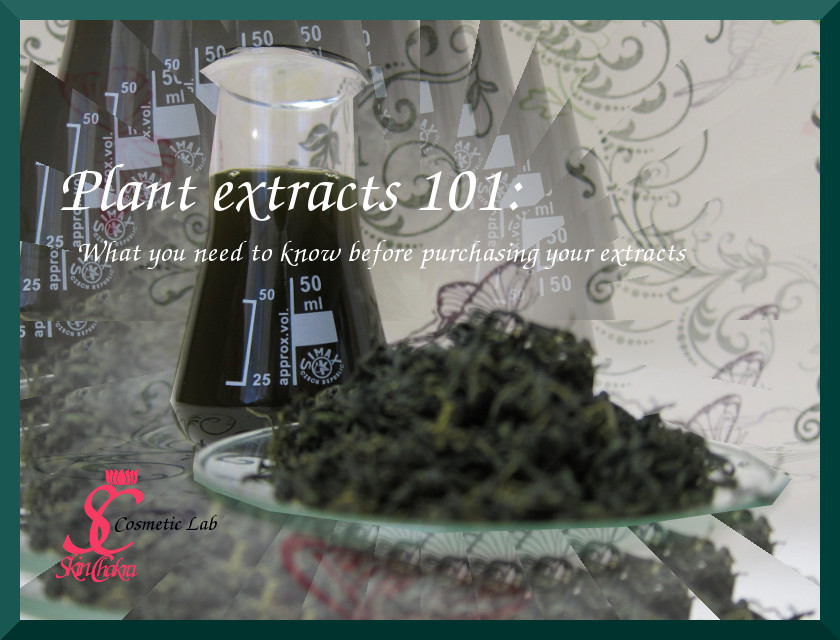
Dienstag, 5. April 2016
Plant extracts 101: Part I
Plant extracts are among essential cosmetic ingredients. Application of plant extracts is no more confined to herbalists or natural and organic cosmetics. Even conventional and mass-market hair and skin care products try to score with plant extracts names on their labels (they are however applied at a minimum possible concentration to keep the costs low and to avoid any contribution of the colour or scent to the finished product).
There are hundreds of different extracts in various forms available: powder, CO2 extracts, glycolic, glyceric or lipophilic extracts.
The diversity is often overwhelming. As it is not eenough, most often the retailers add to the confusion by providing you with insufficient or even misleading information. I'm confronted with this problem in a daily basis when students pay huge sums of money to purchase fanciful extracts they don't know how to apply correctly in their desired products.
No matter whether you're going to make your own extracts (we'll come to this in the coming psost) or using a commercial extract, there are some certain consideration to make before ordering or making your extarcts.
Definition and nomenclature
To add to our confusion, the terms infusion, decoction, percolation, extraction and maceration are widely exchanged and interchanged. These terms have different meanings when used by food scientists, cosmetic chemists, pharmacists or herbalists.
All of them lead to a kind of extraction of ingredients into a carrier but the methods and the outcomes are quite different.
From a chemical/physical point of view by making an infusion or decoction energy is applied as heat to "extract" certain ingredients from plant material.
- Infusion: you can think about the tea you drink everyday. Hot water is added to the plant material, it is steeped for a short period of time and then the plant material is filtered out. The filtered liquid (tea) is called an infusion.
You may use a carrier oil instead of water for your infusion. In this case dried plant material is added to a warm (but not hot) carrier oil and the oil is filtered after a short while.
- Decoction: we usually refer to a process when the plant material is added to boiling water and is steeped for a period of time (depending on the hardness and nature of the plant)
- Maceration: (which is sometimes exchanged with infusion as well), plant material is added to a carrier oil. Maceration is performed as cold or warm-cold. Usually the procedure takes a few weeks and the plant material is renewed several times during the maceration period. Heat or sun are applied as sources of energy.
- Percolation: the solvent is run through the plant material (like a traditional coffee machine). This could be s one-run like in coffee making or the solvent could be repassed through the plant material several times. This procedure is confined to water and solvents with a low boiling point (acetone, alcohol, hexane for instance)
These are artisan forms of extracting plant material and have been used for decades by herbalists and soap makers. Non of these methods applied mechanical energy. Obviously the more heat you apply the more active ingredients you extract at the expense of damaging heat sensitive ingredients. Usualy the harder the plant material (roots, wood etc.) the longer the required time and the higher the required temperature for extraction.
Tinctures make a unique category of extracts. here a blend of alcohol/water is applied to extract ingredients during a period of several days. The applied alcohol could have a concentration between 20-95%. The harder the plant material (resinoids, wood, root) the higher the required alcohol concentration and the longer the required period to extract active ingredients.
When talking about plant extracts (from a pharmaceutical, cosmaceutical point of view), we usually refer to a process when less heat and more mechanical energy is applied to extract active ingredients from plant material. Application of mechanical energy under controlled temperature provides you with the highest possible concentration of active ingredients without compromising for heat sensitive ingredients. The applied energy is either ultrasound energy or mechanical energy of a crusher.
Although extracts and infusions are often interchanges (and ironically, there is no difference in the legislative nomenclature of extracts and infusions), you shall consider real extracts as infusions with some 200 times more active ingredients.
This difference is clearly mirrored in application dosage: While you can replace 100% of your water phase or your oil phase with an infusion, you usually do not apply any plant extract more than 5% in a formulation.
Follow to part II.
I would very much like to hear your opinion about extracts and infusions and how you apply them in your products.
Feel free to send me your questions, comments and photos. I really enjoy your participation in our Facebook discussions.

